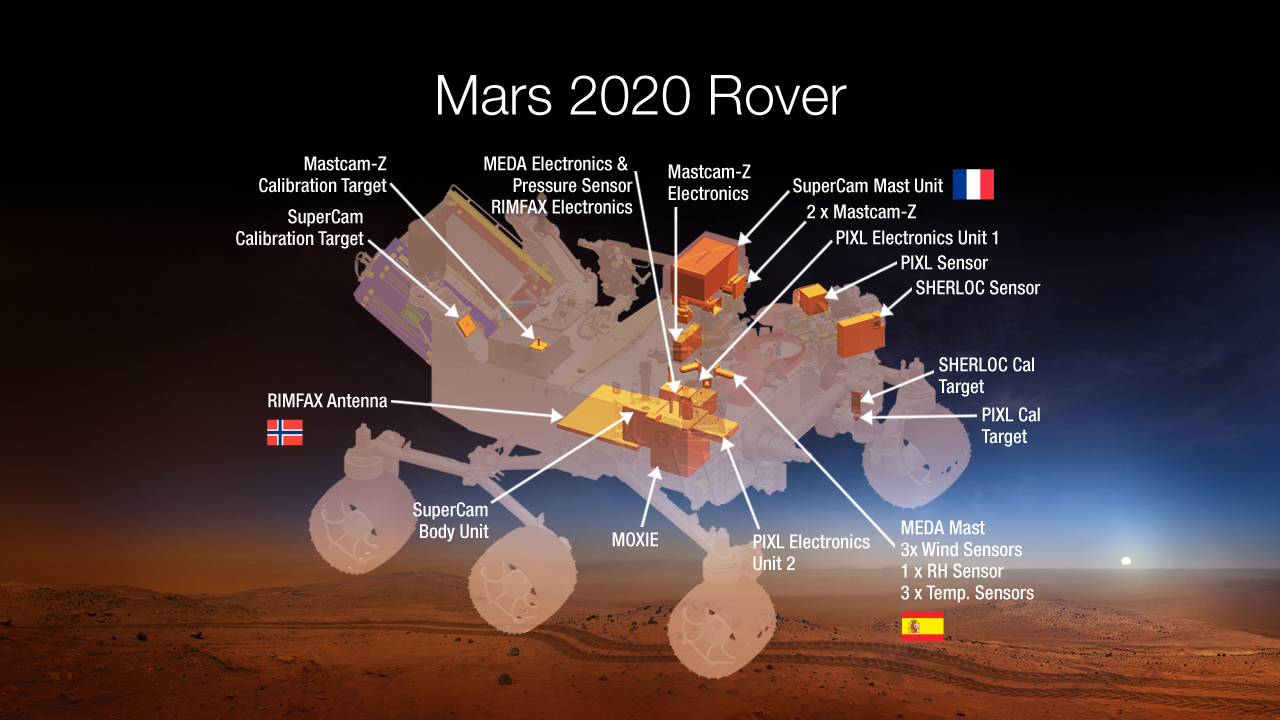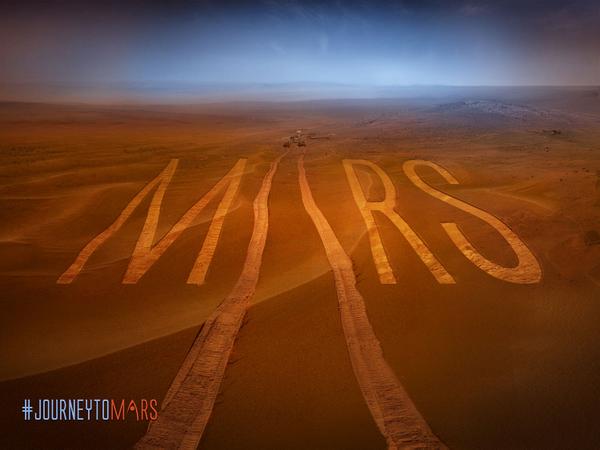
The advanced science payload package that will launch on NASA’s next car-sized rover to the Red Planet in 2020 on a ground breaking mission, seeking signs of past life while also testing key technology to prepare for future human explorers, was announced by NASA managers today, Thursday, July 31, in a media briefing at the space agency’s headquarters in Washington.
The ambitious and innovative Mars 2020 rover instruments include the first camera with a zoom lens capable of 3-D imaging, ground penetrating radar, lasers, an investigation to produce oxygen usable as rocket fuel and for humans to breathe, a weather station, and a rock sample caching system for retrieval and return to Earth by an undefined future mission.
The instruments will work in concert as much as feasible in examining rocks to give scientists the best chance of finding organic molecules, looking for direct evidence of ancient life, and searching for minerals that are indicative of a habitable zone that could support microbial life in the past or even today, if it exists.
A science suite of seven high-powered instruments was selected for development and integration onto the Mars 2020 rover from a competition that drew 58 proposals from science and engineering teams worldwide—double the usual number and exemplifying a deep interest in robotic exploration by the science community.

All the proposals were submitted by January 2014 and have since been evaluated and scrutinized by NASA management to meet the twin challenge of producing the best possible science to search for organic molecules as precursors to life while simultaneously advancing the goal of humans to Mars by testing technology for using the planet’s own natural resources to enable future astronauts expeditions as early as the 2030s.
“The 2020 Mars rover will build on the science from Curiosity and other Mars missions,” said John Grunsfeld, astronaut and associate administrator of NASA’s Science Mission Directorate at the briefing.
“The rover carries innovative new instruments to look for signs of past life. Unless we try hard things we will never advance.”
The seven winning instruments will conduct an unprecedented combination of science and technology investigations, furthering the search for life and helping to enable manned missions to the Red Planet.
“The Mars 2020 rover, with these new advanced scientific instruments, including those from our international partners, holds the promise to unlock more mysteries of Mars’ past as revealed in the geological record,” said John Grunsfeld, astronaut and associate administrator of NASA’s Science Mission Directorate in Washington.
“This mission will further our search for life in the universe and also offer opportunities to advance new capabilities in exploration technology.”

Two instruments will be located on the mast (Mastcam-Z and Supercam), three on the rover body (MOXIE, MEDA, and RIMFAX), and two more on the robotic arm (PIXL and SHERLOC).
Overall, the science instrument package weighs about 45 kilograms, compared to about 70 kilograms for Curiosity.
The 2020 rover is the next big step on Mars, building on prior missions and paving the way for future human missions,” said Jim Green, Director of NASA’s Planetary Division at NASA HQ.
Mars 2020 is truly an international mission. Two of the seven instruments come from Spain and Norway, and there is significant international participation on several others.
“Over 50 institutions are represented worldwide,” said Michael Meyer, lead scientist for NASA’s Mars Exploration Program.
“All seven instruments will work together and no measurements are done only by one instrument.”
The technology demonstration experiment, dubbed the Mars Oxygen ISRU Experiment (MOXIE), is essentially a critical demonstration of using Mars’ natural occurring resources for “living off the land.” Atmospheric carbon dioxide (the main constituent of Mars atmosphere) will be used to generate oxygen—useful both as rocket fuel and for the survival of human explorers. Enormous amounts of money can be saved by implementing ISRU (In Situ Resource Utilization) rather than ferrying all life support supplies from Earth across hundreds of millions of miles of interplanetary space.
MOXIE Principal Investigator Michael Hecht of MIT said that the goal is to “produce 20 grams of oxygen per hour on 50 occasions during the mission.”
“The 2020 rover will help answer questions about the Martian environment that astronauts will face and test technologies they need before landing on, exploring and returning from the Red Planet,” said William Gerstenmaier, associate administrator for the Human Exploration and Operations Mission Directorate at NASA Headquarters in Washington.
“Mars has resources needed to help sustain life, which can reduce the amount of supplies that human missions will need to carry. Better understanding the Martian dust and weather will be valuable data for planning human Mars missions. Testing ways to extract these resources and understand the environment will help make the pioneering of Mars feasible.”
In order to cut costs and development time the rover will leverage the science and landing architecture developed for NASA’s Curiosity Mars Science Laboratory (MSL) rover that successfully accomplished an unprecedented and dramatic pinpoint landing on Mars on Aug. 5, 2012, using the rocket assisted skycrane descent maneuver.

NASA said that the overall Mars 2020 program cost is about $1.9 billion, including some $130 million to design and build the seven instruments suite. Since the new rover is essentially an MSL 2 except for the science instruments, most of the development risks have been retired and the cost is significantly less than the approximate $2.4 billion cost for Curiosity.
Several instruments will be capable of detecting very low levels of organic molecules, the science team told AmericaSpace. Organics are essential precursors to life.
The Mars 2020 rover will also have a sample cacher with the ability to store up to 31 core samples collected by the rover’s drill for later retrieval and return to Earth at an as yet unspecified time.
“The purpose of the cacher is to find samples so compelling that they are worth returning to Earth,” said Grunsfeld.

Here is the complete list of the science suite of seven payloads, descriptions, and principal investigators chosen for NASA’s 2020 Mars rover:
— Mastcam-Z, an advanced camera system with panoramic and stereoscopic imaging capability with the ability to zoom. The instrument also will determine mineralogy of the Martian surface and assist with rover operations. The principal investigator is James Bell, Arizona State University in Phoenix.
Bell is a leading member of the Mars Exploration Rover (MER) science team and lead investigator for the Pancam camera instrument on Spirit and Opportunity.
— SuperCam, an instrument that can provide imaging, chemical composition analysis, and mineralogy. The instrument will also be able to detect the presence of organic compounds in rocks and regolith from a distance. The principal investigator is Roger Wiens, Los Alamos National Laboratory, Los Alamos, N.M. This instrument also has a significant contribution from the Centre National d’Etudes Spatiales, Institut de Recherche en Astrophysique et Plane’tologie (CNES/IRAP) France.
— Planetary Instrument for X-ray Lithochemistry (PIXL), an X-ray fluorescence spectrometer that will also contain an imager with high resolution to determine the fine scale elemental composition of Martian surface materials. PIXL will provide capabilities that permit more detailed detection and analysis of chemical elements than ever before. The principal investigator is Abigail Allwood, NASA’s Jet Propulsion Laboratory (JPL) in Pasadena, Calif.
— Scanning Habitable Environments with Raman & Luminescence for Organics and Chemicals (SHERLOC), a spectrometer that will provide fine-scale imaging and uses an ultraviolet (UV) laser to determine fine-scale mineralogy and detect organic compounds. SHERLOC will be the first UV Raman spectrometer to fly to the surface of Mars and will provide complementary measurements with other instruments in the payload. The principal investigator is Luther Beegle, JPL.
— The Mars Oxygen ISRU Experiment (MOXIE), an exploration technology investigation that will produce oxygen from Martian atmospheric carbon dioxide. The principal investigator is Michael Hecht, Massachusetts Institute of Technology, Cambridge, Mass.
— Mars Environmental Dynamics Analyzer (MEDA), a set of sensors that will provide measurements of temperature, wind speed and direction, pressure, relative humidity, and dust size and shape. The principal investigator is Jose Rodriguez-Manfredi, Centro de Astrobiologia, Instituto Nacional de Tecnica Aeroespacial, Spain.
— The Radar Imager for Mars’ Subsurface Exploration (RIMFAX), a ground-penetrating radar that will provide centimeter-scale resolution of the geologic structure of the subsurface. The principal investigator is Svein-Erik Hamran, Forsvarets Forskning Institute, Norway.
Therefore the instruments are a mix of more sophisticated, upgraded hardware versions working on Curiosity at this moment, as well as new instruments to conduct geological assessments of the rover’s landing site, determine the potential habitability of the environment, and directly search for signs of ancient Martian life, according to NASA.
“While getting to and landing on Mars is hard, Curiosity was an iconic example of how our robotic scientific explorers are paving the way for humans to pioneer Mars and beyond,” said NASA Administrator Charles Bolden, in a statement.
“Mars exploration will be this generation’s legacy, and the Mars 2020 rover will be another critical step on humans’ journey to the Red Planet.”

NASA is currently developing the mammoth SLS booster and the Orion crew capsule with plans aimed at launching the first astronauts to Mars in the 2030s.
Stay tuned here for Ken’s continuing updates.
Want to keep up-to-date with all things space? Be sure to “Like” AmericaSpace on Facebook and follow us on Twitter: @AmericaSpace




Mars 2020 is yet another significant step in the exploration of the red planet. What is truly amazing is what will be learned about capturing oxygen from the Martian atmosphere. Can’t wait until 2020!
But why would you waste payload on a mobile scientific platform on a science experiment that doesn’t require mobility? Why not put it on the Mars Insight?
Doug,
I think they probably need the Nuclear “battery” to power this Oxygen experiment rather than solar power….
“NASA said that the overall Mars 2020 program cost is about $1.9 billion, including some $130 million to design and build the seven instruments suite. Since the new rover is essentially an MSL 2 except for the science instruments, most of the development risks have been retired and the cost is significantly less than the approximate $2.4 billion cost for Curiosity.”
It really good to know that the US taxpayer got such a big savings on this Rover of $500M….Just kidding…